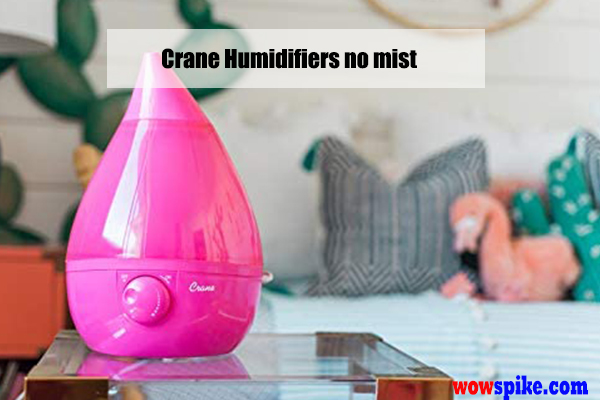Table of Contents [Show]
 |
Crane humidifier no mist
If you're having trouble getting your crane humidifier to produce mist, there are a few things you can try.
If you've noticed that your humidifier has been leaking water from the bottom, there are a few possible explanations.
An ultrasonic humidifier is a type of humidifier that uses high frequency sound waves to create water vapor. The water vapor is then dispersed into the air, providing moisture to the room or area. Ultrasonic humidifiers are often used in homes and office spaces to help improve air quality and relieve dryness.
If you're not sure whether your humidifier is working, there are a few things you can check.
When the humidifier isn't working, there are a few things that can be done.
There are a few reasons why your humidifier may not be raising humidity levels in your home as much as you’d like.
If your humidifier isn't producing mist, there are a few things you can check.
If you suffer from allergies, you know that they can make your life miserable. Allergies can cause a runny nose, sneezing, itchy eyes, and more.
A cool mist humidifier is a device that increases the humidity in the air. It does this by evaporating water into the air. This can be beneficial for people who have respiratory problems, dry skin, or sinuses.
In the winter, furnace humidifiers can improve your comfort by adding much-needed moisture to the air. But how does a humidifier work on a furnace, and is it the right choice for your home?
A humidifier can help prevent the spread of COVID-19 by keeping the air in your home moist. Dry air is one of the conditions that can lead to the virus spreading, so by keeping the air moist, you can create an environment that is less favorable for the virus.
An ultrasonic humidifier is a type of humidifier that uses high frequency sound vibrations to create water droplets from a water reservoir. These water droplets are then expelled into the air, providing moisture and humidity. Ultrasonic humidifiers are often used to improve indoor air quality, as they can help to reduce dryness, static electricity, and dust in the air.
An ultrasonic humidifier is a type of humidifier that uses high frequency vibrations to generate water droplets. Ultrasonic humidifiers are often used in homes and office buildings to improve air quality and prevent dryness.
- First, make sure that the unit is filled with water. If it's empty, it won't be able to produce any mist.
- Also, check the filter and make sure it's clean. A dirty filter can restrict airflow and prevent the humidifier from working properly.
- If you've tried these things and your humidifier still isn't working, contact the manufacturer for assistance.
1015 Hawthorn Dr., Itasca, IL 60143,USA
Phone: 847-290-7401
FAX :847-290-7402
Email :customer-service@crane-usa.com
If you notice that your humidifier isn't releasing any mist, there could be a few reasons why:
No mist coming out of humidifier
- The first reason could be that the unit isn't turned on. Check to see if the power cord is plugged into an outlet and that the unit is switched to the "on" position.
- Another possibility is that the humidifier's water tank is empty. Be sure to check the water level and refill the tank if necessary.
- Finally, make sure that the humidifier's wick filter isn't clogged with mineral deposits. If it is, soak it in white vinegar for 30 minutes, then rinse it thoroughly before using again.
Why is my humidifier leaking from the bottom?
- First, it's possible that the unit isn't level. When a humidifier isn't level, the water inside can start to leak out. To fix this, simply adjust the feet on the bottom of the unit until it's level.
- Another possibility is that the tank isn't seated correctly on the base. If the tank isn't snug against the base, it can cause leaks. To fix this, lift up the tank and make sure that it's properly aligned with the base before setting it back down.
- Finally, it's possible that there is something blocking the valve in the base of the unit. If there is something blocking the valve, water can't flow into the tank and will instead leak out.
Homedics humidifier not working red light
If your Homedics humidifier isn't working and the red light is on, don't panic. There are a few things you can check before you call customer service.- First, make sure the humidifier is properly plugged into an outlet.
- Next, check the water level in the tank. If it's low, refill it and try again.
- If those two things don't work, then there may be something wrong with the humidifier itself. In that case, you'll need to contact Homedics customer service for assistance.
Humidifier won't turn on after cleaning
If your humidifier won't turn on after you've cleaned it, there are a few things you can check.- First, make sure that the humidifier is plugged into an outlet and that the switch is in the "on" position.
- Next, check to see if there is water in the reservoir. If the reservoir is empty, fill it with fresh water and try again.
- Finally, if the humidifier still won't turn on, you may need to replace the filter.
How does ultrasonic humidifier work?
How does an ultrasonic humidifier work? An ultrasonic humidifier has a metal diaphragm that vibrates at a high frequency when electricity is applied. This vibration creates tiny water droplets that are dispersed into the air as water vapor.
The ultrasonic humidifier is a relatively new technology, but it has quickly become one of the most popular types of humidifiers on the market.
There are many benefits to using an ultrasonic humidifier.
The answer is yes! Adding a humidifier to your home can actually increase the temperature, according to new research. The study, conducted by the University of Colorado Boulder, found that when air is more humid, it feels warmer than dry air at the same temperature.
Does humidifier increase temperature?
"Our research shows that relative humidity has a big impact on how warm or cool we perceive our environment," said lead author Xueying Wang. "As the climate continues to change and we experience more extreme weather conditions, it's important to understand how humidity will affect how comfortable we feel."
To conduct the study, researchers had subjects sit in a room with different levels of humidity while wearing light clothing. They found that when the relative humidity was increased from 20 to 60 percent, participants felt an average of 3.6 degrees warmer.
If you over humidify a room, it can cause condensation on the walls and floors, which can lead to mold and mildew. If you have asthma or allergies, this can make your symptoms worse. Too much humidity can also make your home feel stuffy and uncomfortable.
Humidifiers can last for many years with proper care and maintenance. However, the lifespan of a humidifier will depend on the type of humidifier, how often it is used, and how well it is maintained.
What happens if you over humidify a room?
How long do humidifiers last?
For example, an ultrasonic humidifier may only last for a few years while a whole-house humidifier can last for 10 years or more.
To prolong the life of your humidifier and keep it working properly, be sure to follow the manufacturer’s instructions for care and maintenance.
If you notice that your humidifier is not working, there are a few things that you can do in order to fix the problem.
What to do if humidifier is not working?
- First, check to see if the humidifier is turned on. If it is not, turn it on and wait a few minutes to see if the humidifier starts working.
- If the humidifier is still not working, check to see if there is water in the reservoir. If there is no water in the reservoir, add water and wait a few minutes to see if the humidifier starts working.
- If the humidifier still is not working, you may need to clean it. To clean your humidifier, follow the instructions in your user manual.
How do I know if my humidifier is working?
- First, look at the unit to see if the water level has decreased. If it has, then the humidifier is working.
- You can also check the air around the humidifier to see if it feels more moist than it did before you turned on the humidifier.
- Finally, you can use a hygrometer to measure the humidity in the room; if it's increased, then your humidifier is working.
What to do when humidifier doesn't work
- First, check to see if there is water in the reservoir. If there is no water, then the humidifier can't produce any mist.
- Second, check to see if the wick is saturated. If it's not, then it won't be able to produce any mist.
- Finally, check to see if the humidifier is turned on. If it's not, then it won't be able to produce any mist.
Why is my humidifier not raising humidity?
- First, check to make sure that the humidifier is the right size for the room you’re using it in. If the room is too large, the humidifier will have a hard time keeping up.
- Second, make sure that the water tank is full and that there’s no sediment build-up inside of it.
- Third, check the Humidistat to see if it’s set to the correct level. If it’s set too low, the humidifier won’t run as often and won’t add enough moisture to the air.
- Finally, if you have an ultrasonic humidifier, make sure that there isn’t any mineral build-up on the transducer plate.
Ultrasonic humidifier not producing mist
- First, make sure that the water tank is filled to the correct level. If it's too low, the humidifier won't be able to produce mist.
- Next, check the filter and make sure it's clean. A dirty filter can block the flow of water and prevent mist from being produced. 3.Finally, make sure that the unit is turned on and set to the correct setting.
- If everything looks good and the humidifier still isn't producing mist, it may be time to buy a new one.
How does humidifier help baby?
The answer is Yes! A humidifier can also help to prevent baby from getting sick.
A humidifier is a device that increases moisture in the air. This can be beneficial for people who suffer from dry skin, sinus problems, or respiratory issues. When baby’s nasal passages are dry, they are more susceptible to viruses. By using a humidifier, you can help to keep baby’s nose moist which will create a barrier against cold and flu viruses. A humidifier can also help to relieve congestion and coughs by thinning out mucus.
If you live in a dry climate, or if it is wintertime, then you may want to consider using a humidifier in your home. By doing so, you can help your family breathe easier and stay healthy all season long!
How does humidifier help with allergies
But did you know that a humidifier can help with allergies?
- A humidifier adds moisture to the air, which can help to relieve some of the symptoms of allergies.
- Dry air can make your nose and throat feel dry and irritated, but adding moisture to the air can help to soothe these symptoms.
- In addition, a humidifier can help to reduce the amount of dust and pollen in the air.
- When the air is dry, these particles float around and are easily inhaled.
- But when the air is moist, they tend to stick to surfaces and are not as easily inhaled.
How does a cool mist humidifier work?
Cool mist humidifiers can also help to reduce static electricity in the home.
There are two types of cool mist humidifiers: ultrasonic and evaporative.
- Ultrasonic cool mist humidifiers use a vibrating plate to create a fine mist.
- Evaporative cool mist humidifiers use a wick to absorb water and then blow air through it to create evaporation.
Cool mist humidifiers can be used with essential oils to provide aromatherapy benefits. Some cool mist humidifiers also have filters that can remove impurities from the water before it is vaporized.
How does humidifier work on furnace?
- A furnace humidifier is a whole-house unit that attaches to your forced-air heating system.
- As air from the furnace passes over the humidifier’s water reservoir, evaporation adds moisture to the air.
- This moistened air then circulates through your ductwork and into your rooms.
Furnace humidifiers are an efficient way to add humidity because they don’t require any extra energy to run. And since they’re attached to your furnace, they can evenly distribute humidity throughout your entire home.
A humidifier is a device that helps to maintain the level of humidity in the air. There are many different types of humidifiers, but the most common type is the whole house humidifier.
How does a whole house humidifier work?
The whole house humidifier is attached to your home’s HVAC system and works by adding moisture to the air as it is circulated through your vents. This type of humidifier is ideal for homes in dry climates or during winter months when the air is particularly dry.
Whole house humidifiers are available in a variety of sizes and styles to suit your needs. Some models even come with features like automatic humidity controls and filters to help improve indoor air quality.
An ultrasonic humidifier is a device that adds moisture to the air. It is often used to help with respiratory problems, dry skin, and static electricity.
Ultrasonic humidifier how to use
The ultrasonic humidifier uses a piezoelectric transducer to create vibrations in water. This causes the water to break into very fine droplets and be released into the air as a cool mist.
To use an ultrasonic humidifier:
- you will need to fill the device with water.
- you can then choose a setting on the humidifier, such as low, medium, or high.
- The amount of mist that is released into the air will depend on the setting that you choose.
- You may also need to add a few drops of essential oil to the water before turning on the device.
How does humidifier help covid?
Additionally, a humidifier can help relieve some of the symptoms associated with COVID-19, such as a dry cough. If you are using a humidifier to prevent the spread of COVID-19, be sure to clean it regularly and follow the manufacturer’s instructions.
When it comes to humidifiers, there are two main types: evaporative and ultrasonic. So, which is better?
Which is better evaporative or ultrasonic humidifier?
- Evaporative humidifiers work by using a wick to absorb water from a reservoir and then disperse it into the air. They are generally less expensive than ultrasonic humidifiers and are easier to clean. However, they can be noisy and may not be as effective in larger rooms.
- Ultrasonic humidifiers use high frequency vibrations to create water droplets that are then dispersed into the air. They are typically quieter than evaporative humidifiers and can be more effective in larger rooms. However, they may be more expensive and can be more difficult to clean.
What is an ultrasonic humidifier?
Ultrasonic humidifier benefits
There are several benefits of using an ultrasonic humidifier:
- Improved Air Quality: Ultrasonic humidifiers can help to improve the air quality in your home or office by reducing dust and other airborne particles. Additionally, the humidity generated by an ultrasonic humidifier can help to reduce static electricity in the air, making it less likely for dust and other particles to become airborne.
- Prevention of Dryness: One of the most common complaints during winter months is dryness, which can lead to a variety of health problems such as nosebleeds, chapped lips, and respiratory infections.










0 Comments:
Post a Comment